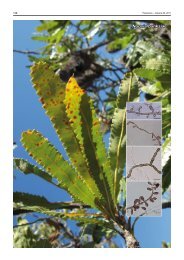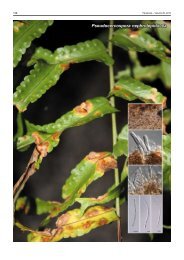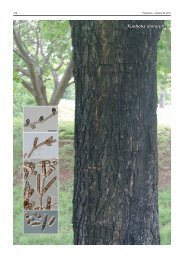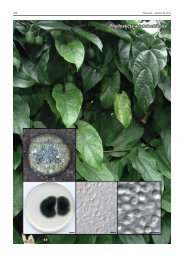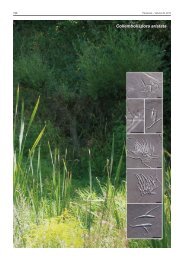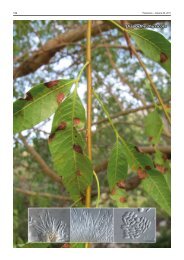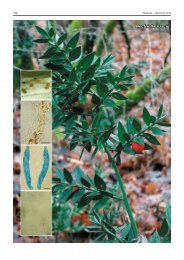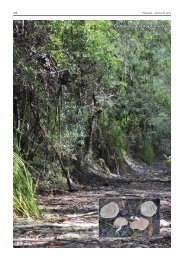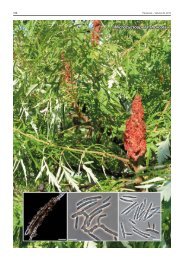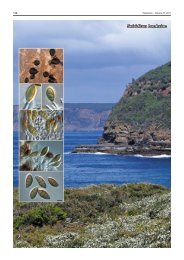Bagadiella koalae - Fungal Planet
Bagadiella koalae - Fungal Planet
Bagadiella koalae - Fungal Planet
You also want an ePaper? Increase the reach of your titles
YUMPU automatically turns print PDFs into web optimized ePapers that Google loves.
126 Persoonia – Volume 26, 2011<br />
<strong>Bagadiella</strong> <strong>koalae</strong>
<strong>Fungal</strong> <strong>Planet</strong> description sheets<br />
127<br />
<strong>Fungal</strong> <strong>Planet</strong> 77 – 31 May 2011<br />
<strong>Bagadiella</strong> <strong>koalae</strong> Crous, Pascoe, I.J. Porter & Jacq. Edwards, sp. nov.<br />
<strong>Bagadiella</strong>e lunatae similis, sed conidiis majoribus, (15–)17–20 × 1.5–2 µm,<br />
discernitur.<br />
Etymology. Named after the koala that was observed eating these Eucalyptus<br />
globulus leaves.<br />
On potato-dextrose agar. Conidiophores aggregated in brown<br />
fascicles on leaves. In culture on potato-dextrose agar, sporulating<br />
on conidiophores that occur solitary on hyphae. Mycelium<br />
consisting of medium brown, smooth, septate, 2–2.5 µm diam<br />
hyphae. Conidiophores subcylindrical, brown, smooth, straight<br />
to gently curved, 1–3-septate, 15–30 × 3–4 µm. Conidiogenous<br />
cells terminal, integrated, pale to medium brown, smooth, 7–15<br />
× 2–3 µm; apex with flared collarette, 1–2 × 2–3 µm. Conidia<br />
hyaline, smooth, curved, with bluntly rounded apex and truncate<br />
base, (15–)17–20 × 1.5–2 µm.<br />
Culture characteristics — (in the dark, 25 °C, after 1 mo):<br />
Colonies spreading, flat, with sparse aerial mycelium, and submerged,<br />
feathery margin, reaching 35–60 mm diam; on potatodextrose<br />
agar, surface grey olivaceous, reverse olivaceous<br />
grey; on oatmeal agar surface umber with patches of peach;<br />
on malt extract agar surface ochreous, reverse umber.<br />
Typus. Australia, Victoria, Otway Ranges, Kennett River, Great Ocean<br />
Road, on leaves of Eucalyptus globulus eaten by koala, 18 Oct. 2009, P.W.<br />
Crous, I.G. Pascoe, I.J. Porter & J. Edwards, holotype CBS H-20583, cultures<br />
ex-type CPC 17682 = CBS 129523, ITS sequence GenBank JF951142 and<br />
LSU sequence GenBank JF951162, MycoBank MB560166.<br />
Notes — Based on a megablast search of NCBI’s GenBank<br />
nucleotide database, the closest hits using the ITS sequence<br />
are <strong>Bagadiella</strong> sp. CPC 16622 (GQ303270; Identities = 706/713<br />
(99 %), Gaps = 4/713 (1 %)) and <strong>Bagadiella</strong> lunata (GQ303269;<br />
Identities = 702/707 (99 %), Gaps = 1/707 (0 %)) (Cheewangkoon<br />
et al. 2009). These associations were also supported by<br />
the LSU sequence. <strong>Bagadiella</strong> victoriae is distinct on its ITS<br />
sequence (Identities = 705/712 (99 %), Gaps = 4/712 (1 %))<br />
and LSU sequence (Identities = 918/922 (99 %), Gaps = 0/922<br />
(0 %)).<br />
Colour illustrations. Koala at Kennett River, eating leaves of Eucalyptus<br />
globulus from which B. <strong>koalae</strong> was isolated; conidiogenous cells and conidia.<br />
Scale bar = 10 µm.<br />
Pedro W. Crous & Johannes Z. Groenewald, CBS-KNAW <strong>Fungal</strong> Biodiversity Centre, P.O. Box 85167, 3508 AD Utrecht, The Netherlands;<br />
e-mail: p.crous@cbs.knaw.nl & e.groenewald@cbs.knaw.nl<br />
Ian G. Pascoe, Ian J. Porter & Jacqueline Edwards, Biosciences Research Division, Department of Primary Industries, P. Bag 15,<br />
Ferntree Gully Delivery Centre, Victoria 3156, Australia;<br />
e-mail: pascoeig@bigpond.net.au, ian.j.porter@dpi.vic.gov.au & jacky.edwards@dpi.vic.gov.au<br />
© 2011 Nationaal Herbarium Nederland & Centraalbureau voor Schimmelcultures




